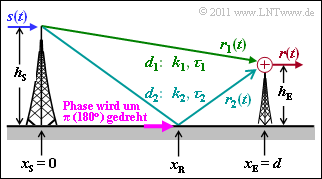Exercise 2.2Z: Real Two-Path Channel
The sketched scenario is considered in which the transmitted signal s(t) reaches the antenna of the receiver via two paths: r(t) = r1(t)+r2(t)=k1⋅s(t−τ1)+k2⋅s(t−τ2).
Note the following:
- The delays τ1 and τ2 of the main and secondary paths can be calculated from the path lengths d1 and d2 using the speed of light c=3⋅108 m/s .
- The amplitude factors k1 and k2 are obtained according to the path loss model with path loss exponent γ=2 (free-space attenuation).
- The height of the transmit antenna is hS=500 m. The height of the receiving antenna is hE=30 m. The antennas are separated by a distance of d=10 km.
- The reflection on the secondary path causes a phase change of π, so that the partial signals must be subtracted. This is taken into account by a negative k2 value.
Note:
- This task belongs to the chapter Mehrwegeempfang beim Mobilfunk.
Questionnaire
Sample solution
- Actually, specifying such a length with an accuracy of one millimeter is not very useful and contradicts the mentality of an engineer.
- We have done this anyway to be able to check the accuracy of the approximation in subtask 4 (4).
(2) If you fold the reflected beam on the right side of xR downwards (reflection on the ground), you get again a right triangle. From this follows: d2=√d2+(hS+hE)2=√102+(0.5+0.03)2km=10014.035m_.
(3) With the results from (1) and (2) you get for the lengths– and the runtime difference:
- $$\Delta d = d_2 - d_1 = \hspace{0.1cm} \underline {=2,996\,{\rm m} \hspace{0.05cm},\hspace{1cm} \delta \tau = \frac{\delta d}{c} = \frac{2,996\,{\rm m}}}{3 \cdot 10^8 \,{\rm m/s}} \hspace{0.1cm} \underline {=9,987\,{\rm ns} \hspace{0.05cm}.$$
(4) With hS+hE≪d the above equation can be expressed as follows: $$d_1 \hspace{-0.1cm} \ = \ \hspace{-0.1cm} d \cdot \sqrt{1 + \frac{(h_{\rm S}- h_{\rm E})^2}{d^2} \approx d \cdot \left [ 1 + \frac{(h_{\rm S}- h_{\rm E})^2}{2d^2} \right ] \hspace{0.05cm},\hspace{1cm} d_2 \hspace{-0.1cm} \ = \ \hspace{-0.1cm} d \cdot \sqrt{1 + \frac{(h_{\rm S}+ h_{\rm E})^2}{d^2} \approx d \cdot \left [ 1 + \frac{(h_{\rm S}+ h_{\rm E})^2}{2d^2} \right ]
- So the correct solution is the solution 3. With the given numerical values you get for this:
Δτ≈2⋅500m⋅30m3⋅108m/s⋅10000m=10−8s=10ns.
- The relative falsification to the actual value according to the subtask '(3) is only 0.13%.
- In solution 1 the unit is already wrong.
- In solution 2, there would be no propagation delay if both antennas were the same height. This is certainly not true.
(5) The path loss exponent γ=2 says that the reception power PE decreases quadratically with distance.
- The signal amplitude thus decreases with 1/d, and with a constant K applies:
- k1=Kd1,|k2|=Kd2⇒|k2|k1=d1d2=10011,039m10014,035m≈0.99.
- The two path weights thus only differ in amount by about 1%.
- However, the coefficients k1 and k2 have different signs ⇒ Correct are the answers 1 and 3.
